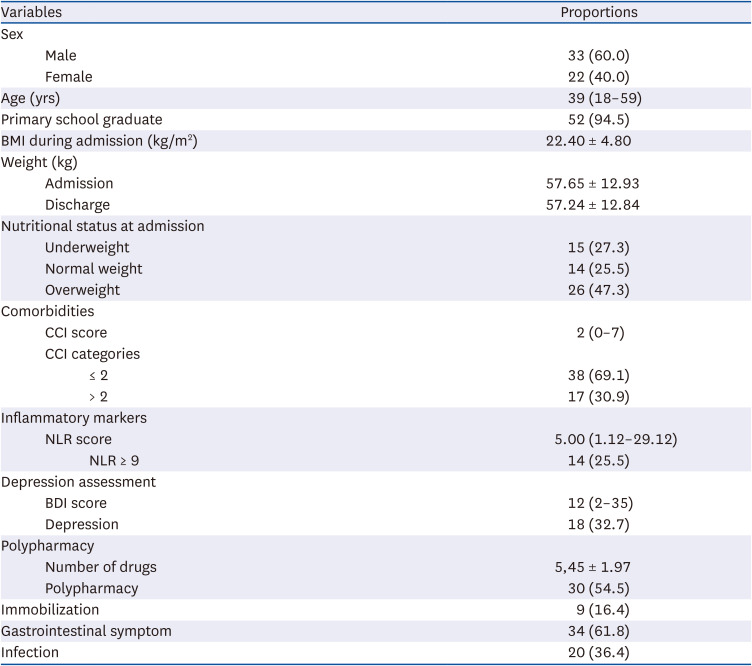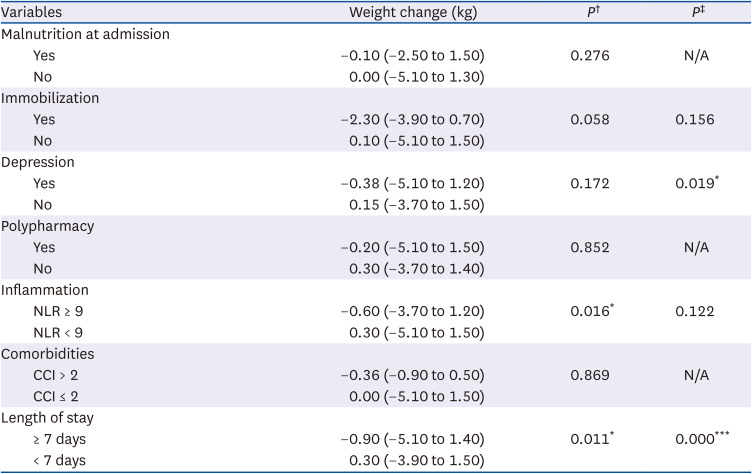1. Barker LA, Gout BS, Crowe TC. Hospital malnutrition: prevalence, identification and impact on patients and the healthcare system. Int J Environ Res Public Health. 2011; 8:514–527. PMID:
21556200.
2. White JV, Guenter P, Jensen G, Malone A, Schofield M. Academy Malnutrition Work Group. A.S.P.E.N. Malnutrition Task Force. A.S.P.E.N. Board of Directors. Consensus statement: Academy of Nutrition and Dietetics and American Society for Parenteral and Enteral Nutrition: characteristics recommended for the identification and documentation of adult malnutrition (undernutrition). JPEN J Parenter Enteral Nutr. 2012; 36:275–283. PMID:
22535923.
3. Braunschweig C, Gomez S, Sheean PM. Impact of declines in nutritional status on outcomes in adult patients hospitalized for more than 7 days. J Am Diet Assoc. 2000; 100:1316–1322. PMID:
11103653.
4. Correia MI, Waitzberg DL. The impact of malnutrition on morbidity, mortality, length of hospital stay and costs evaluated through a multivariate model analysis. Clin Nutr. 2003; 22:235–239. PMID:
12765661.
5. Hill GL. Disorders of Nutrition and Metabolism in Clinical Surgery. Edinburgh: Churchill Livingstone;1992.
6. De Stefani FD, Pietraroia PS, Fernandes-Silva MM, Faria-Neto J, Baena CP. Observational evidence for unintentional weight loss in all-cause mortality and major cardiovascular events: a systematic review and meta-analysis. Sci Rep. 2018; 8:15447. PMID:
30337578.
7. Susetyowati S, Yenita Y, Kurnianda J. Initial nutritional status based on the Patient-Generated Subjective Global Assessment (PG-SGA) is Associated with nutrient intake and weight changes in inpatient cancer patients at RSUP Dr. Mohammad Hoesin Palembang. J Gizi Klinik Indones. 2010; 7:80–84.
8. Kusumayanti IGA, Hadi H, Susetyowati S. Factors that influence the incidence of malnutrition in adult patients in the inpatient hospital. J Gizi Klinik Indones. 2004; 1:9–17.
9. Budiningsari RD, Hadi H. Effect of changes in nutritional status of adult patients on length of stay and hospital costs. J Gizi Klinik Indones. 2004; 1:35–44.
10. Dwiyanti D, Hadi H, Susetyowati S. Effect of food intake on the incidence of malnutrition in the hospital. J Gizi Klinik Indones. 2004; 1:1–7.
11. Smith S, Chamblee TB, Saeed KF, Haight K, Shuster MH, Waldo MJ, Yoon HL. Malnutrition in Hospitalized Adult Patients: The Role of the Clinical Nurse Specialist. Wakefield (MA): National Association of Clinical Nurse Specialists;2017.
12. Hartman C, Eliakim R, Shamir R. Nutritional status and nutritional therapy in inflammatory bowel diseases. World J Gastroenterol. 2009; 15:2570–2578. PMID:
19496185.
13. Lipoeto NI, Megasari N, Putra AE. Malnutrition and calorie intake in hospitalized patients. Madjalah Kedokt Indones. 2006; 56:1–14.
14. Prasetyo WA, Probosuseno S. Depressive disorders associated with the nutritional status of psychogeriatric patients at RSJ Dr. Radjiman Wediodiningrat, Malang. Indones J Nutr Diet. 2015; 3:22–30.
15. Syam AF, Sobur CS, Abdullah M, Makmun D. Nutritional status of hospitalized nonsurgery patients at a nationwide referral hospital in Indonesia. J Int Dent Med Res. 2018; 11:732–739.
16. Bunawan NC, Suseno D, Dillon DH, Rinaldi I, Purnamasari D. Risk factors for undernutrition at admission among adult hospitalized patients at a referral hospital in Indonesia. SAGE Open. 2021; 11:1–6.
17. Paramita AP. Model prediksi tinggi badan pada kelompok dewasa muda dengan prediktor tinggi lutut di FKM UI tahun 2012 [bachelor’s thesis]. Depok: Universitas Indonesia;2012.
18. Ginting H, Naring G, Veld VW, Srisayekti W, Becker ES. Validating the Beck Depression Inventory-II in Indonesia’s general population and coronary heart disease patient. Int J Clin Health Psychol. 2013; 13:235–242.
19. Weta IW, Wirasmadi NL. Adequacy of nutrients and changes in the nutritional status of patients while being treated at the Sanglah Central General Hospital, Denpasar. Gizi Indones. 2009; 32:139–149.
20. Allard JP, Keller H, Jeejeebhoy KN, Laporte M, Duerksen DR, Gramlich L, Payette H, Bernier P, Davidson B, Teterina A, et al. Decline in nutritional status is associated with prolonged length of stay in hospitalized patients admitted for 7 days or more: a prospective cohort study. Clin Nutr. 2016; 35:144–152. PMID:
25660316.
21. Young LS, Huong PT, Lam NT, Thu NN, Van HT, Hanh NL, Tuyen D, Lien DT, Hoc TH, Tuyet CT, et al. Nutritional status and feeding practices in gastrointestinal surgery patients at Bach Mai Hospital, Hanoi, Vietnam. Asia Pac J Clin Nutr. 2016; 25:513–520. PMID:
27440685.
22. Klek S, Chourdakis M, Abosaleh DA, Amestoy A, Baik HW, Baptista G, Barazzoni R, Fukushima R, Hartono J, Jayawardena R, et al. Health insurance or subsidy has universal advantage for management of hospital malnutrition unrelated to GDP. Asia Pac J Clin Nutr. 2017; 26:247–254. PMID:
28244702.
23. Konturek PC, Herrmann HJ, Schink K, Neurath MF, Zopf Y. Malnutrition in hospitals: it was, is now, and must not remain a problem! Med Sci Monit. 2015; 21:2969–2975. PMID:
26431510.
24. Correia MI, Perman MI, Waitzberg DL. Hospital malnutrition in Latin America: a systematic review. Clin Nutr. 2017; 36:958–967. PMID:
27499391.
25. Schuetz P, Fehr R, Baechli V, Geiser M, Deiss M, Gomes F, Kutz A, Tribolet P, Bregenzer T, Braun N, et al. Individualised nutritional support in medical inpatients at nutritional risk: a randomised clinical trial. Lancet. 2019; 393:2312–2321. PMID:
31030981.
26. National Collaborating Centre for Acute Care. Nutrition Supports for Adults: Oral Nutrition Support, Enteral Tube Feeding, and Parenteral Nutrition. London: National Collaborating Centre for Acute Care;2006.
27. Moens MM. Prevalence of risk of malnutrition in hospitalised adult patients in a tertiary hospital setting in South Africa [master’s thesis]. Stellenbosch: University of Stellenbosch;2016.
28. Wang H, Ye J. Regulation of energy balance by inflammation: common theme in physiology and pathology. Rev Endocr Metab Disord. 2015; 16:47–54. PMID:
25526866.
29. Durmus E, Kivrak T, Gerin F, Sunbul M, Sari I, Erdogan O. Neutrophil to lymphocyte ratio and platelet to lymphocyte ratio are predictors of heart failure. Arq Bras Cardiol. 2015; 105:606–613. PMID:
26536980.
30. Arif SK, Rukka AB, Wahyuni S. Comparison of neutrophils-lymphocytes ratio and procalcitonin parameters in sepsis patient treated in intensive care unit Dr. Wahidin Hospital, Makassar, Indonesia. J Med Sci (Faisalabad, Pak). 2017; 17:17–21.
31. American Psychiatric Association. Diagnostic and Statistical Manual of Mental Disorders. 5th ed. Washington, D.C.: American Psychiatry Publishing;2013.
32. Pryce CR, Fontana A. Depression in autoimmune disease. Dantzer R, Capuron L, editors. Inflammation-Associated Depression: Evidence, Mechanism, and Implications. Cham: Springer International Publishing;2016. p. 139–154.
33. Zhu M, Wei J, Chen W, Yang X, Cui H, Zhu S. Ad hoc Working Group. Nutritional risk and nutritional status at admission and discharge among chinese hospitalized patients: a prospective, nationwide, multicenter study. J Am Coll Nutr. 2017; 36:357–363. PMID:
28548607.
34. FOOD Trial Collaboration. Poor nutritional status on admission predicts poor outcomes after stroke: observational data from the FOOD trial. Stroke. 2003; 34:1450–1456. PMID:
12750536.
35. Knight J, Nigam Y, Jones A. Effects of bedrest 2: gastrointestinal, endocrine, renal, reproductive and nervous systems. Nurs Times. 2009; 105:24–27.
36. Hickson M. Malnutrition and ageing. Postgrad Med J. 2006; 82:2–8. PMID:
16397072.
37. Harris CL, Fraser C. Malnutrition in the institutionalized elderly: the effects on wound healing. Ostomy Wound Manage. 2004; 50:54–63.









 PDF
PDF Citation
Citation Print
Print



 XML Download
XML Download